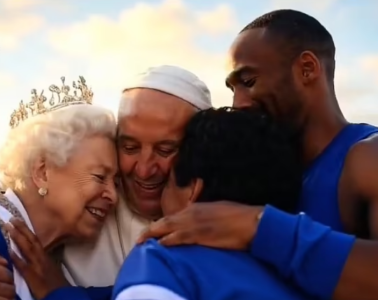AI places unexpected figure in heaven with Pope—viral video sparks outrage online
By
Gian T
- Replies 20
The internet has seen its fair share of controversy, but a recent AI-generated video has left many unsettled.
The unsettling content has sparked widespread reactions, with some viewers expressing anger and others feeling deeply disturbed.
As the video spreads, discussions about its implications have become more intense.
The 31-second clip, which has already racked up a staggering 38 million views, shows a digital version of Pope Francis—who passed away at age 88—wandering through a computer-generated 'heaven' and embracing various famous faces from across history.
But it’s not just the impressive technology that’s got people talking; it’s the choice of 'heavenly' companions and the idea of using AI to resurrect the dead for entertainment that’s sparked a furious backlash.
Who’s in the Video? The AI video, titled 'Pope Francis meeting some old friends,' features the late pontiff sharing hugs and smiles with a who’s who of late celebrities and public figures.
An AI-generated video of Pope Francis in heaven, hugging deceased celebrities, has sparked outrage online, with many calling it 'creepy' and 'disrespectful'.
Among those depicted are:
Why Are People So Upset? While some viewers saw the video as a touching tribute, many others quickly called it 'creepy,' 'disrespectful,' and even 'blasphemous.'
Social media platforms like X (formerly Twitter) lit up with angry comments: 'This is one of the most sickening and horrendous things I’ve ever seen. How dare you desecrate the Pope’s memory like this!.'
'To show him in ‘heaven’ with Michael Jackson, who is arguably a paedophile, is blasphemous in the extreme.' another said.
'This is not cute, but creepy. Why would he be old friends with people he never met like Kobe or Paul Walker? Wouldn’t he rather be with his family?' a third echoed.
'Can we not use AI for dead people? This is weird.'
Some viewers also pointed out the oddity of including Stephen Hawking—who was famously an atheist and didn’t believe in heaven—still depicted in his wheelchair.
A Question of Respect and Consent
One of the biggest issues raised by critics is respect for the deceased and their families.
None of the people featured in the video consented (for obvious reasons), and many viewers felt that using their likenesses in this way was deeply inappropriate.
There’s also the matter of context. The video places the Pope—one of our time's most significant religious figures—alongside celebrities from wildly different backgrounds, some of whom were embroiled in controversy during their lifetimes.
For many, this felt like a trivialisation of both the Pope’s legacy and the lives of the other figures depicted.
The Rise of AI 'Deepfakes' and Digital Resurrection
This isn’t the first time AI has been used to bring the dead 'back to life.'
In recent years, we’ve seen everything from hologram concerts featuring long-gone musicians to AI-generated voiceovers of deceased actors.
While some find these tributes moving, others are concerned about the ethical implications, such as who decides how someone's image is used after they pass, whether it’s acceptable to use AI to create performances or appearances for those who can't consent, and where to draw the line between tribute and exploitation.
For older Australians, these questions might feel especially pressing.
Many of us grew up in a time when a person’s legacy was shaped by their real-life actions and memories—not by what a computer could conjure up decades later.
What Does This Mean for the Future?
As AI technology becomes more advanced and accessible, we’re likely to see more of these digital resurrections—whether we like it or not.
Some experts are calling for clearer laws and guidelines around the use of AI-generated images and videos, especially when it comes to deceased individuals.
In the meantime, it’s up to all of us to think critically about what we watch and share online. Just because something is technically possible doesn’t mean it’s right—or respectful.
 Have you seen the video? How do you feel about AI being used to create images and videos of people who have passed away? Is it a harmless tribute, or does it cross a line? We’d love to hear your thoughts and experiences—share your opinion in the comments below.
Have you seen the video? How do you feel about AI being used to create images and videos of people who have passed away? Is it a harmless tribute, or does it cross a line? We’d love to hear your thoughts and experiences—share your opinion in the comments below.
The unsettling content has sparked widespread reactions, with some viewers expressing anger and others feeling deeply disturbed.
As the video spreads, discussions about its implications have become more intense.
The 31-second clip, which has already racked up a staggering 38 million views, shows a digital version of Pope Francis—who passed away at age 88—wandering through a computer-generated 'heaven' and embracing various famous faces from across history.
But it’s not just the impressive technology that’s got people talking; it’s the choice of 'heavenly' companions and the idea of using AI to resurrect the dead for entertainment that’s sparked a furious backlash.
Who’s in the Video? The AI video, titled 'Pope Francis meeting some old friends,' features the late pontiff sharing hugs and smiles with a who’s who of late celebrities and public figures.
An AI-generated video of Pope Francis in heaven, hugging deceased celebrities, has sparked outrage online, with many calling it 'creepy' and 'disrespectful'.
Among those depicted are:
- Queen Elizabeth II
- Princess Diana
- Michael Jackson
- Muhammad Ali
- Amy Winehouse
- Robin Williams
- Tupac Shakur
- Paul Walker
- Kobe Bryant
- Diego Maradona
- Stephen Hawking
- Pelé
- Mac Miller
- Chadwick Boseman
- Cameron Boyce
- Pope John Paul II
Why Are People So Upset? While some viewers saw the video as a touching tribute, many others quickly called it 'creepy,' 'disrespectful,' and even 'blasphemous.'
Social media platforms like X (formerly Twitter) lit up with angry comments: 'This is one of the most sickening and horrendous things I’ve ever seen. How dare you desecrate the Pope’s memory like this!.'
'To show him in ‘heaven’ with Michael Jackson, who is arguably a paedophile, is blasphemous in the extreme.' another said.
'This is not cute, but creepy. Why would he be old friends with people he never met like Kobe or Paul Walker? Wouldn’t he rather be with his family?' a third echoed.
'Can we not use AI for dead people? This is weird.'
Some viewers also pointed out the oddity of including Stephen Hawking—who was famously an atheist and didn’t believe in heaven—still depicted in his wheelchair.
One of the biggest issues raised by critics is respect for the deceased and their families.
None of the people featured in the video consented (for obvious reasons), and many viewers felt that using their likenesses in this way was deeply inappropriate.
There’s also the matter of context. The video places the Pope—one of our time's most significant religious figures—alongside celebrities from wildly different backgrounds, some of whom were embroiled in controversy during their lifetimes.
For many, this felt like a trivialisation of both the Pope’s legacy and the lives of the other figures depicted.
This isn’t the first time AI has been used to bring the dead 'back to life.'
In recent years, we’ve seen everything from hologram concerts featuring long-gone musicians to AI-generated voiceovers of deceased actors.
While some find these tributes moving, others are concerned about the ethical implications, such as who decides how someone's image is used after they pass, whether it’s acceptable to use AI to create performances or appearances for those who can't consent, and where to draw the line between tribute and exploitation.
For older Australians, these questions might feel especially pressing.
Many of us grew up in a time when a person’s legacy was shaped by their real-life actions and memories—not by what a computer could conjure up decades later.
As AI technology becomes more advanced and accessible, we’re likely to see more of these digital resurrections—whether we like it or not.
Some experts are calling for clearer laws and guidelines around the use of AI-generated images and videos, especially when it comes to deceased individuals.
In the meantime, it’s up to all of us to think critically about what we watch and share online. Just because something is technically possible doesn’t mean it’s right—or respectful.
Key Takeaways
- An AI-generated video depicting Pope Francis in heaven, hugging various deceased celebrities and public figures, has sparked outrage online, with many branding it ‘creepy’, ‘disrespectful’, and ‘blasphemous’.
- The video features the late Pope interacting with personalities such as Princess Diana, Muhammad Ali, Michael Jackson, Amy Winehouse, the Queen, and Stephen Hawking.
- Many social media users criticised the video for being insensitive, questioning the inclusion of controversial figures and pointing out the absurdity of pairing the Pope with celebrities he never met.
- Critics further condemned the video for using AI to create content with deceased individuals, labelling it dystopian and calling for an end to this type of exploitative digital material.









